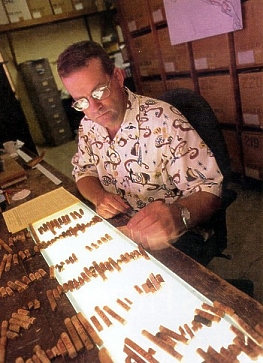
James A. Parks (Research Specialist)

Mr. Parks, Research Specialist, earned a B.A. degree in history from The University of Arizona in 1990. In 1987, he began his career in dendrochronology as a a student asssitant to D. A. Graybill working on bristlecone pine dating, verification, and chronology building. In 1991, he transferred to the archaeological research program where he has worked on a variety of projects. Parks has participated in a number of field projects including bristlecone pine collecting for the "Early Holocene Dendrochronology and Calibration of C-14 Dating" project (Graybill, J. S. Dean, and D. J. Donohue PIs); living tree sampling in connection with chronology building and dendroclimatic studies undertaken by Graybill, Dean, and T. W. Swetnam; living and dead tree sampling for a pinyon dieback study in the Sevilleta NSF Long-Term Environmental Research Area with Swetnam and J. L. Betancourt of the USGS; buried and flood scarred-tree sampling for geological studies by V. A. S. McCord; and archaeological sampling at sites in Mesa Verde National Park under Dean's supervision.. In addition, he helped collect and prepare samples for radiocarbon dating, trace element analysis, and geological dating. As a student, Parks was awarded both the Alsie French Schulman and Edmund Schulman Memorial Scholarship and the Andrew Ellicott Douglass Memorial Scholarship by the the Laboratory, and well as receiving two undergraduate research grants from The University of Arizona Honors Center.
During the last seven years (written in 1999), Parks derived 809 dates from 2,036 archaeological tree-ring samples, analyzed nearly 500 samples from dead bristlecone and pinyon remnants, and analyzed nearly 700 cores from living trees. Included in these efforts were the dating of numerous samples from six cliff dwellings in Mesa Verde National Park and preparing reports on two of these, one of which is in press. He analyzed 4,000-year-old buried geological samples from Carnegie canyon, Oklahoma, as part of a study of climatic variablility in the Holocene. In another study, he helped document recent changes in spring discharge in northeastern Arizona. In connection with the Sevilleta project, Parks undertook chronology building and dendroclimatic reconstructions that were incorporated into a paper (now in press) on the role of drought in eighteenth century population dislocations in the Rio Grande Valley. Finally, he assistant M.W. Salzer in extending the San Francisco Peaks bristlecone chronology back to 662 B.C., an addition of more than 1,000 years. This chronology will be used in conjunction with local ponderosa pine sequences to investigate interactions between precipitation and temperature in the Flagstaff area over the last 1,500 years.
(Taken from the Laboratory of Tree-Ring Research Academic Program Review: 1998-1999.)